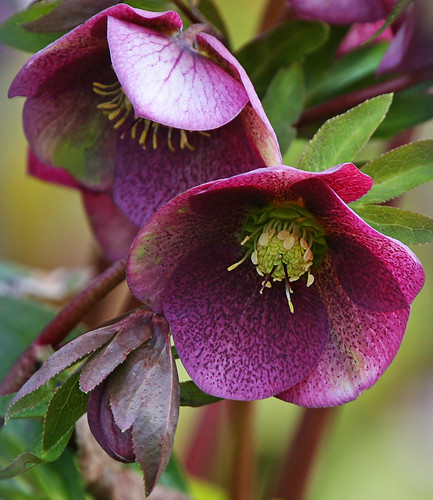
If the reader is like TheGardenLady, he or she is eager to see outdoor flowers in bloom at this time of the year because flowers really are the signal that it is the end of winter. Those lucky enough to have Hellebores might already be smiling if they have flowers on their plants. Those who don’t have these early blooming plants might want to consider planting Hellebores in their gardens, either as plants or the seeds, in order to have a very early blooming plant with such a pretty flower.
Hellebores’ common name is the Christmas Rose or the Lenten Rose.
Though some people think the flower looks something like a wild rose, Hellebores are not roses; they are in the Ranunculus family which includes the buttercup. But the Hellebores blooms so early either in December or February, (it blooms close to Lent or Christmas and can bloom in the snow) that they were given these common names.
Hellebores are not native to the US; they were native to much of Europe, the Mediterranean, the Balkans and some rare types are native in the near East and China. Hellebores have always been a favorite choice for the English gardener and are one of Britain’s oldest cultivated plants, believed to have been introduced by the Romans. And they seem to be popular around the world including the US where they have a huge group of admirers and breeders.
Besides their early and long lasting bloom period, Hellebores have lovely, fairly large flowers in many shades of white, greenish white, pinks and purples. Some, like the Brandywine Hellebores, have freckles and edges of color and now hybridizers have a double-flowering hellebore. The majority of Hellebore plants had flowers that bowed down when in bloom, but today hybridizers have created plants with flowers that now look up at you. Either way, Hellebores are pretty while in bloom and make excellent indoor floral
arrangements because they are also long-lasting cut flowers.
There are Hellebores that grow from zone 4 through zone 10. They love to grow in shaded areas, under deciduous trees which shed their leaves in the winter. They prefer limey soil but will grow in acidy soil, which means one
can grow good plants in pretty much any soil. They will grow in chalky, gravelly and heavy clay, but need the addition of plenty of organic matter; so mix in the compost you have been making. Hellebores love moist soil, so they like mulch if they are planted in drier areas.
Hellebores are long living plants that do not require a great deal of attention during the year. Like all plants, Hellebores do have problems, but they are relatively problem free and therefore easy to grow. TheGardenLady has never had any problems with her Hellebores. But one major problem can be black spot. Most of the time, all one has to do is cut off the infected leaves and discard them. The other major problem, TheGardenLady read, is that mice and, I guess, voles love to eat the plants. You should put mouse traps near the plants if you have this problem.
There are very good books on growing Hellebores. “The Gardener’s Guide
to Growing Hellebores” by Graham Rice & Ekuzabeth Strangman is one
excellent book.
Some websites that sell Hellebores are Barry Glick’s Sunfarm. Barry says they “grow virtually every Hellebore species within the genus and maintain more than 50,000 flowering size stock plants for seed production” or check out this site. If you live near David Culp, the hybridizer of the Brandywine Hellebore, and can take a tour of his garden when it is open for tours, you will be delighted with his spring garden which highlights the Hellebore. A site with good answers about Hellebores is Honey Hill Farm Nursery or look at this site.
